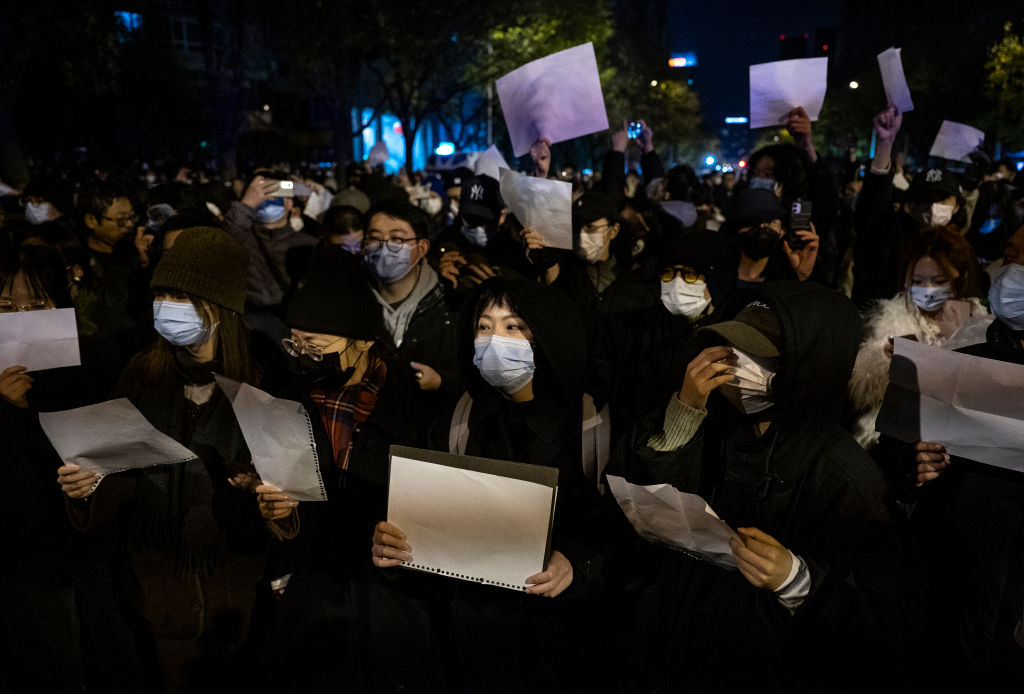Across China, the world’s most populous nation and its second largest economy, scenes unprecedented since the Tiananmen Square massacre of 1989 are unfolding. In city after city crowds of young people are taking to the streets, holding up blank placards in eloquent protest against state censorship, and demanding to be treated ‘as citizens not slaves’.
The trigger for these displays of popular dissent are the Communist regime’s draconian lockdowns designed to snuff out spreading Covid infections in the country where the virus originated. But, as is often the way with such popular protests, the original cause of the protests is widening into demands for freedoms which we in the West take for granted but which those taking part in the demonstrations have never known.
Some of the protesters’ demands – ominously coming from universities training China’s future ruling elite – now seem to go beyond the lifting of stringent lockdowns. Videos of the protests appear to show protestors calling for such strange western concepts as democracy and free elections. There are even demands for the end of Communist party rule and the downfall of the recently renewed dictatorship of President Xi Jinping.
Meanwhile, in the Islamic Republic of Iran, protests ignited in September with the death in custody of Mahsa Amini, a young woman arrested by religious police for the way she wore her hijab – the headdress which all Iranian women are legally compelled to wear in public. They are continuing, and have even penetrated the ranks of the clerical caste who have ruled the country with an iron fist since 1979.
Xi Jinping and Ayatollah Khameini may sleep easy in their beds for now, but regimes born in blood often drown in it too
In the latest manifestation of widespread discontent, Farideh Moradkhani, niece of Iran’s supreme leader Ayatollah Ali Khamenei, released a video condemning the country’s leadership. She called on other countries to cut all ties with the regime led by her uncle until they stop the brutal repression of the unrest which has already taken more than 400 lives. Her brave gesture follows the equally bold refusal by Iran’s World Cup team to sing the national anthem at the start of their opening match.
So do these outbreaks of simultaneous but coincidental protest against the repressive regimes in Beijing and Teheran mean the Ayatollahs should tremble in their sandals for the future of their state? Should President Xi be considering a future career away from politics?
Such a prospect still seems a distant mirage in either case. As the slaughter of unknown hundreds of student dissidents in Beijing’s Tiananmen Square in 1989 proved, China’s rulers will stop at nothing to crush any serious opposition to their dictatorial rule.
Moreover, in the decades since the unknown ‘tank man’ came to symbolise China’s spirit of resistance by standing in lonely defiance against an armoured column advancing through Beijing, technological progress has strengthened the totalitarian state’s armoury of repression. The Chinese regime can and does imprison and kill its opponents without a second thought. Facial recognition, DNA fingerprinting and China’s credit scoring system have combined to ensure that only the bravest of the brave – or the most desperate – dare to raise their voices against it.
But technology has also helped those courageous enough to dissent. Social media means that, despite the regime’s energetic efforts to hide and censor the truth, images and messages showing the protests and repression are beamed out over the internet. They are seen and heard across the vast country in seconds.
A savage regime with similar tools of repression at its disposal, Iran too has frequently demonstrated its willingness to mow down demonstrators and execute opponents en masse. History, however, shows that the fall of authoritarian regimes that push their people too far can come with sudden and unforeseen swiftness.
The Ayatollahs of Iran should remember their own history, which offers a lesson on how revolutions can burst forth from seemingly clear skies. The Islamic Republic only came about after prolonged and bloody demonstrations against the former regime of the Shah escalated after more than a year of grumbling discontent. Defying the Shah’s fearsome secret police, the Savak, and the bullets of his soldiers, ever more numerous crowds turned out in mass demonstrations against him.
The tipping point came when the Shah’s security forces tired of repressing their own brothers and sisters and joined the revolution. The monarch flew into exile and Ayatollah Khomeini arrived to inaugurate the Islamic Republic.
Similarly, the Chinese Communist party’s rule has repeatedly been punctuated by murderous purges and the removal of party leaders who have made mistakes or lost the favour of those they rule. Xi Jinping and Ayatollah Khameini may sleep easy in their beds for now, but regimes born in blood often drown in it too.






Comments